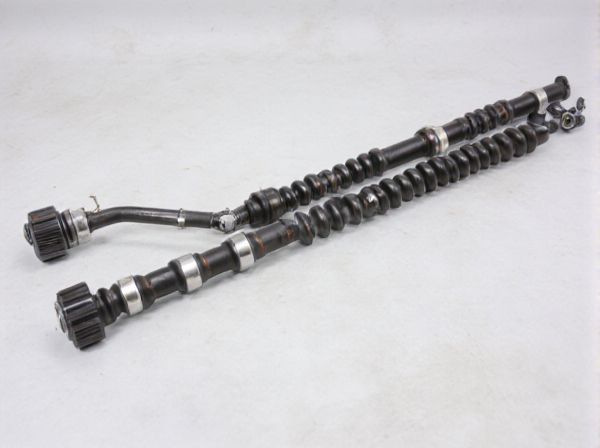
Photo illustration: Double Cardan vs Single Cardan
Double Cardan joints provide smoother power transmission and reduced vibration compared to Single Cardan joints, making them ideal for applications requiring higher precision and durability. Single Cardan joints are simpler, less expensive, and suitable for moderate angles but may cause more shaft vibration at higher angles. Your choice depends on the required torque capacity, operating angle, and desired longevity.
Table of Comparison
| Feature | Double Cardan Driveshaft | Single Cardan Driveshaft |
|---|---|---|
| Design | Two universal joints with an intermediate yoke | One universal joint |
| Vibration Reduction | Superior, minimizes angular velocity variations | Moderate, prone to vibration at higher angles |
| Operating Angle | Higher operating angle capability (up to 40 degrees) | Limited operating angle (typically up to 25 degrees) |
| Durability | Enhanced durability due to balanced joint motion | Less durable under high-stress or high-angle conditions |
| Cost | Higher cost due to complex construction | Lower cost and simpler design |
| Common Applications | Off-road vehicles, heavy-duty trucks, high-performance cars | Standard passenger vehicles, light-duty trucks |
Introduction to Cardan Joints
Cardan joints, also known as universal joints, are mechanical components that allow transmission of rotary motion between two shafts at varying angles. The Single Cardan joint features one cross-shaped component enabling angular displacement, suitable for lower torque and moderate angles up to 30 degrees. In contrast, the Double Cardan joint combines two universal joints connected by a center yoke, providing smoother power transfer, reduced vibration, and the ability to handle larger operating angles near 45 degrees with improved driveline stability.
What is a Single Cardan Joint?
A single Cardan joint, also known as a universal joint, is a mechanical connection that allows the transfer of rotary motion between two shafts at an angle. It consists of a cross-shaped pivot that enables flexibility in axis alignment, accommodating angular misalignments up to a certain degree. Compared to a double Cardan joint, a single Cardan joint is simpler but may introduce more vibration and uneven rotational speed at higher angles.
What is a Double Cardan Joint?
A Double Cardan joint consists of two universal joints connected by a center yoke, allowing for smoother power transfer and reduced vibration in drivetrains compared to a Single Cardan joint. It effectively cancels out the angular velocity fluctuations common in single universal joints, providing greater flexibility and durability in off-road vehicles and heavy-duty applications. This design enhances the performance of the driveshaft by maintaining constant velocity at varying angles, improving overall drivetrain efficiency.
Key Differences Between Single and Double Cardan
Single Cardan joints use one universal joint and experience angular velocity fluctuations, leading to potential vibration and wear at higher operating angles. Double Cardan joints consist of two universal joints connected by a centering yoke, minimizing velocity variations and providing smoother torque transmission, especially at extreme angles. Key differences include operational smoothness, ability to handle higher angles, and reduced vibration, making double Cardan preferable in heavy-duty or high-angle applications.
Performance and Efficiency Comparison
Double Cardan driveshafts provide superior vibration damping and smoother power transmission than Single Cardan models, especially at higher angles of operation up to 25 degrees. Their dual universal joints arranged with an intermediate shaft reduce angular velocity variations, resulting in increased drivetrain efficiency and less wear on components. Single Cardan driveshafts perform adequately at lower angles but suffer from more vibration and reduced lifespan under demanding conditions, making Double Cardan a better choice for high-performance and heavy-duty applications.
Applications: When to Use Single vs Double Cardan
Single Cardan joints are typically used in applications with minimal angle variation, such as standard rear-wheel-drive vehicles and agricultural machinery where alignment remains consistent. Double Cardan joints are preferred in high-angle, heavy-duty applications like off-road vehicles, lifted trucks, and industrial equipment requiring smoother power transfer and reduced vibration under severe driveline angles. Choosing between Single and Double Cardan depends on torque capacity, operating angle, and the need to minimize driveline vibrations for specific mechanical systems.
Durability and Maintenance Factors
Double Cardan driveshafts provide enhanced durability due to their ability to reduce vibration and distribute torque more evenly across universal joints, resulting in less wear compared to Single Cardan shafts. Single Cardan driveshafts have simpler designs but are more prone to wear and require more frequent maintenance because of higher stress concentration on individual joints. Maintenance intervals for Double Cardan setups are generally longer, lowering overall service costs and improving reliability in demanding applications.
Cost Analysis: Single vs Double Cardan
Single Cardan joints typically offer lower upfront costs due to simpler design and fewer components, making them favorable for budget-sensitive applications. Double Cardan driveshafts, though more expensive initially, provide enhanced durability and reduced maintenance costs over time by minimizing vibration and improving angular range. Choosing between Single vs Double Cardan should factor in lifecycle expenses where Double Cardan often leads to long-term savings despite higher initial investment.
Common Issues and Troubleshooting
Double Cardan driveshafts commonly face issues like vibration caused by improper alignment or worn centering bearings, impacting driveline smoothness. Single Cardan driveshaft problems often include U-joint wear and imbalance, leading to noise and reduced performance. Troubleshooting both types involves checking alignment, inspecting U-joints, and ensuring proper lubrication to prevent premature failure and maintain optimal driveline function.
Choosing the Right Cardan Joint for Your Vehicle
Selecting the right Cardan joint depends on your vehicle's drivetrain and operating conditions. Double Cardan joints offer superior vibration dampening and accommodate greater driveline angles, making them ideal for off-road trucks and lifted SUVs. Single Cardan joints are simpler and cost-effective, suitable for vehicles with minimal articulation and more straightforward suspension setups.
 caratoz.com
caratoz.com